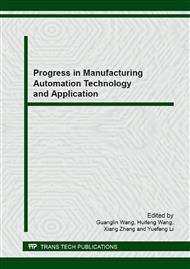p.467
p.476
p.482
p.488
p.493
p.498
p.503
p.507
p.512
Simulation and Experiment Study of Heat Dissipation of Heavy-Duty Vertical Lathe Workbench
Abstract:
In order to obtain the heat dissipation regularity of heavy-duty vertical lathe workbench with a large radius, mathematical model of convection heat transfer is established. According to the model, convection heat transfer process of the workbench is analysed at the velocity of 10~80rpm. The results show that velocity increasing not only impacts a greater influence on the temperature rising of hydrostatic bearing than the temperature rising of workbench, but also drives the heat increased the heat dissipation, degenerated the heat concentration phenomenon. Experimental results shows consistent to the workbench temperature numerical simulation results, the maximum error is 5%, which indicating that the numerical results conform physical regularities, the heat transfer mathematical model extends the range of applications of rotation convection heat transfer, so that vertical lathe heat dissipation situation analysis can be easier and more accurate.
Info:
Periodical:
Pages:
493-497
Citation:
Online since:
September 2013
Authors:
Price:
Сopyright:
© 2014 Trans Tech Publications Ltd. All Rights Reserved
Share:
Citation:


